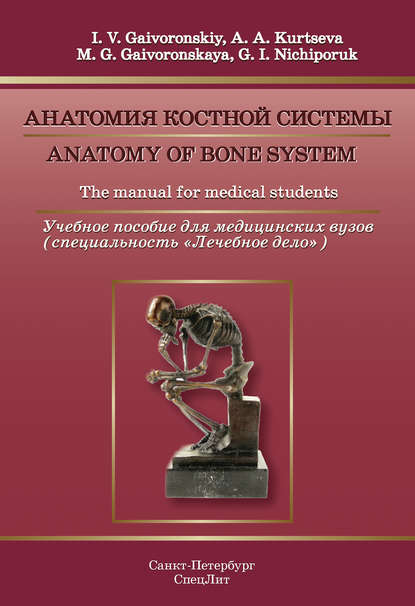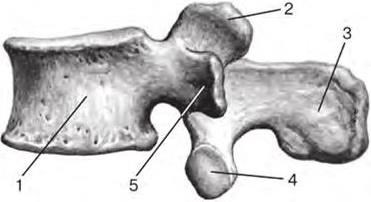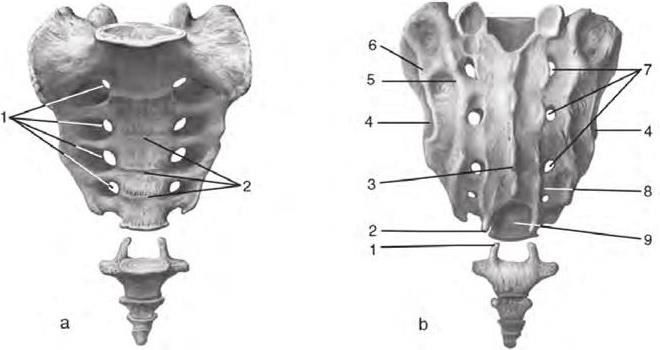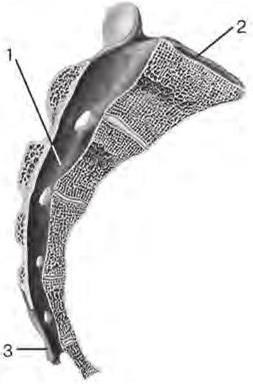
Полная версия:
Anatomy of bone system. The manual for medical students / Анатомия костной системы. Учебное пособие для медицинских вузов
1 – dens (dens); 2 – superior articular facet (facies articularis superioris); 3 – spinous process (processus spinosus); 4 – transverse process (processus transversus); 5 – transverse foramen (foramen transversarium)
The II cervical vertebra is termed the axis, axis (CII). Its distinctive feature is the presence of a dental process or dens, dens axis, projecting vertically from the superior surface of its body. The dens is the body of the atlas relocated during the development (fig. 2.4).
The dens plays the role of a pivot, around which the atlas together with the skull rotates to the right and to the left.
The dens of the II cervical vertebra is cylindrical, it has an apex, apex dentis, and articular facets on its anterior and posterior sides. The anterior articular facet, facies articularis anterior, articulates with fovea dentis of the anterior arch of the atlas; the posterior articular facet, facies articularis posterior, joins with the transverse ligament of the atlas. The axis has no superior articular processes. Instead of them there are slightly convex superior articular facets, facies articulares superiores, are on the sides of the dens. These facets articulate with the inferior articular surfaces on the lateral masses of the atlas. The ends of the transverse processes of the axis are slightly thickened like the ends of the I vertebra; there is the foramen transversarium at the base of each transverse process. The groove for spinal nerve is absent.
2.3. Thoracic Vertebrae
The thoracic vertebrae, vertebrae thoracicae (ThI– ThXII), are much bigger than the cervical vertebrae (fig. 2.1). The height and transverse size of the thoracic vertebrae bodies gradually increase from the I to XII vertebra. The distinctive feature of the thoracic vertebrae is the presence of the articular facets or demi-facets for articulation with ribs. These facets are located on the lateral sides of the bodies and on the transverse processes.
Most vertebrae have two demi-facets. They are directly in front of the pedicle of the vertebral arch: one – at superior edge, the other – at inferior edge. They are called the superior costal facet and inferior costal facet, respectively, fovea costalis superior et fovea costalis inferior. Each such facet (demi-facet to be more precise) of one vertebra, together with the nearest demi-facet of the adjacent vertebra, form an articular area for articulation with the head of the rib. An exception is the I vertebra: it has a complete facet to articulate with the I rib, and a demi-facet to articulate with the II rib. The X vertebra has only the superior demi-facet for articulation with the X rib. The XI and XII vertebrae have one complete facet for articulation with the corresponding ribs.
The articular processes of the thoracic vertebrae are located in the frontal plane. The articular surfaces of superior articular processes are directed backwards, the articular surfaces of the inferior articular processes are directed forwards. The transverse processes are directed laterally and backwards; their length increases from the I to the IX vertebra but then they become shorter. The ends of the transverse processes are thickened. They have a transverse costal facet, fovea costalis processus transversi, for articulation with the tubercle of the rib. The XI and XII vertebrae do not have such facet.
The spinous processes of the thoracic vertebrae are longer than the spinous processes of the cervical vertebrae; they are tilted downwards and lie on each other like tiles.
2.4. Lumbar Vertebrae
The distinctive feature of the lumbar vertebra, vertebrae lumbales (LI– LV), is a beanshaped massive body. The transverse size of the body is wider than the anteroposterior size. The height and width of the body gradually increases from the I to the V vertebrae. The vertebral foramen is large and triangular with rounded angles. The articular processes are well developed, their articular surfaces are located in the sagittal plane: the articular surfaces of the superior processes are directed medially, the articular surfaces of the inferior processes are directed laterally (fig. 2.5).
The superior articular process may have a rudimental tubercle named mammillary process, processus mamillaris. The lumbar vertebra`s transverse processes are formed by fusion of rudimental ribs with the transverse processes of the vertebra. They are located in the frontal plane, their ends are tilted backwards. Often the accessory process, processus accessorius, may be present at the base of the transverse process. The spinous processes are short and flat, their ends are thickened; they are located almost at the same level with the vertebral body and directed backwards.

Fig. 2.5. Lumbar vertebra (lateral aspect):
1 – vertebral body (corpus vertebrae); 2 – superior articular process (processus articularis superior); 3 – spinous process (processus spinosus); 4 – inferior articular process (processus articularis inferior); 5 – transverse process (processus transversus)
2.5. Sacrum
The sacrum, os sacrum (SI– SV), consists of five sacral vertebrae, vertebrae sacrales, which fuse to form a single bone in adults. Two parts and two surfaces are distinguished in the sacrum: the upper wide part, which is the base of the sacrum, basis ossis sacri; the lower part, which is the apex of the sacrum, apex ossis sacri; the anterior (concave) surface, which is the pelvic surface, facies pelviсa; the posterior surface (convex, rough), which is the dorsal surface, facies dorsalis (fig. 2.6).

Fig. 2.6. Sacrum and coccyx:
a – anterior aspect: 1 – anterior sacral foramina (foramina sacralia anteriora); 2 – transverse lines (lineae transversae)
b – posterior aspect: 3 – coccygeal horn (cornu coccygeum); 4 – sacral horn (cornu sacrale); 5 – median sacral crest (crista sacralis mediana); 6 – auricular surface (facies auricularis); 7 – lateral sacral crest (crista sacralis lateralis); 8 – sacral tuberosity (tuberositas ossis sacri); 9 – posterior sacral foramina (foramina sacralia posteriora); 10 – intermediate sacral crest (crista sacralis intermedia); 11 – sacral hiatus (hiatus sacralis)

Fig. 2.7.Sagittal section of sacrum:
1 – sacral canal (canalis sacralis), 2 – base of sacrum (basis ossis sacri); 3 – sacral horn (cornu sacrale)

Fig. 2.8. Horizontal section of sacrum:
1 – posterior sacral foramen (foramen sacrale posterius); 2 – sacral canal (canalis sacralis); 3 – median sacral crest (crista sacralis mediana); 4 – intervertebral foramen (foramen intervertebrale)
The superior articular processes, processus articulares superiores, project from the base of the sacrum; they articulate with the inferior articular processes of the V lumbar vertebra. The place of the junction of the sacrum with the body of the V lumbar vertebra bulges forwards, and is known as the sacral promontory, promontorium.
Four transverse lines, lineae transversae, running horizontally, are visible on the pelvic surface of the sacrum. They are the traces of the fusion of the sacral vertebral bodies. The anterior sacral foramina, foramina sacralia anteriora, open on the right and left ends of these lines.
There are five longitudinal crests on the dorsal surface of the sacrum. The unpaired median sacral crest, crista sacralis mediana, is formed by the fusion of the spinous processes. There is the paired intermediate sacral crest, crista sacralis intermedia, on each side of it. The intermediate sacral crest represents fused articular processes of the sacral vertebrae. There are the posterior intermediate foramina, foramina sacralia posteriora, near the intermediate crests. The paired lateral sacral crest, crista sacralis lateralis, lies laterally to these foramina. It is the trace of the fusion of the transverse processes and rudimental ribs. The paired lateral parts, partes laterales, with the auricular surfaces, facies auriculares, are located outside the posterior sacral foramina. They articulate with the auricular surfaces of the pelvic bone. There is the sacral tuberosity, tuberositas ossis sacri, behind the auricular surfaces. It is connected by ligaments with the tuberosity of the pelvic bone. In the process of the fusion of the sacral vertebrae into a single bone, the vertebral foramina form the sacral canal, canalis caralis (fig. 2.7). It terminates with the sacral hiatus, hiatus sacralis. The sacral horns, cornua sacralia, are on both sides of the hiatus. They are rudiments of the inferior articular processes. The anterior and posterior sacral foramina are connected with the sacral canal by the intervertebral foramina, foramina intervertebralia (fig. 2.8).
2.6. Coccyx
The coccyx, os coccygis (CoI– CoIII-V), consists of 3–5 rudimental vertebrae in adults. Only the I vertebra has rudiments of superior articular processes named coccygeal horns, cornua coccygea, besides the body. The coccygeal horns are connected with the sacral horns by ligaments. The I vertebra also has lateral projections which are rudiments of transverse processes. The other vertebrae are round-shaped and small, they have no arch and no processes.
2.7. Anomalies and Developmental Defects of Vertebrae
Anomalies and developmental defects may be classified according to the following criteria:
I. Vertebral size anomalies:
1. Microspondylia – reduction in size of one or more vertebrae.
2. Brachyspondylia – reduction in width of one or more vertebrae.
3. Platyspondylia – flattening of some vertebrae which get a truncated cone shape.
4. Macrospondylia – increase in size of some vertebrae.
II. Slit-like Defects of Vertebrae:
1. Splitting of vertebral bodies (anterior splitspine, spina bifida anterior) – a slit-like defect of the vertebral body located more often in the sagittal plane.
2. Splitting of the vertebral arch (posterior split spine, spina bifida posterior) – a slit-like defect of the vertebral arch (near a spinous process or on its place).
3. Spondylolysis – in this case, the vertebral body is not fused with the pedicles of the vertebral arch: this anomaly may be observed either on one or on both sides, it happens most often in the V lumbar vertebra or in the I sacral vertebra; in case of bilateral spondylolysis, the posterior part of the arch with the inferior articular processes are separated from the pedicles of the arch with the superior articular processes.
4. Spondylolisthesis – displacement of the body of the upper vertebra frontwards (very seldom – backwards relative to the lower vertebra. Most often it occurs after compressive fracture of a vertebral body when the vertebra becomes wedge-shaped.
5. Rachischisis – in this case the vertebral body is not fused with the pedicles of the vertebral arch, and the vertebral arch is splitted.
III. Development anomalies of individual vertebrae:
1. Assimilation of the atlas:
– atlanto-occipital assimilation (occipitalization) – partial or complete fusion of the I cervical vertebra with the occipital bone: two-sided (symmetric) or one-sided (asymmetric);
– atlantoaxial assimilation – partial or complete fusion of the I and II vertebrae.
2. Manifestation of the atlas (formation of the occipital vertebra – proatlas) –inclusion of the atlas particles into the occipital bone which is manifested in the presence of anomalous bony prominences in the circle of the great (occipital) foramen.
3. Kimmerle`s anomaly – transformation of the vertebral artery groove on the atlas into the canal as a result of formation of a bony outgrowth above this groove.
4. Development anomalies of the II cervical vertebra:
– agenesia (absence) of the dens;
– the dens and the body of the II cervical vertebra are not fused together.
5. Thoracolisation of the cervical vertebrae – formation of cervical ribs (most often from the VII cervical vertebra).
6. Sacralisation – fusion of the V lumbar vertebra with the I sacral vertebra: there are 4 vertebrae in the lumbar part of the vertebral column; the sacrum consists of 6 vertebrae.
7. Lumbarisation – the I sacral vertebra and the II sacral vertebra are not fused together: there are 6 vertebrae in the lumbar part of the vertebral column; the sacrum consists of 4 vertebrae.
Конец ознакомительного фрагмента.
Текст предоставлен ООО «ЛитРес».
Прочитайте эту книгу целиком, купив полную легальную версию на ЛитРес.
Безопасно оплатить книгу можно банковской картой Visa, MasterCard, Maestro, со счета мобильного телефона, с платежного терминала, в салоне МТС или Связной, через PayPal, WebMoney, Яндекс.Деньги, QIWI Кошелек, бонусными картами или другим удобным Вам способом.
Вы ознакомились с фрагментом книги.
Для бесплатного чтения открыта только часть текста.
Приобретайте полный текст книги у нашего партнера:
Полная версия книги
Всего 10 форматов



